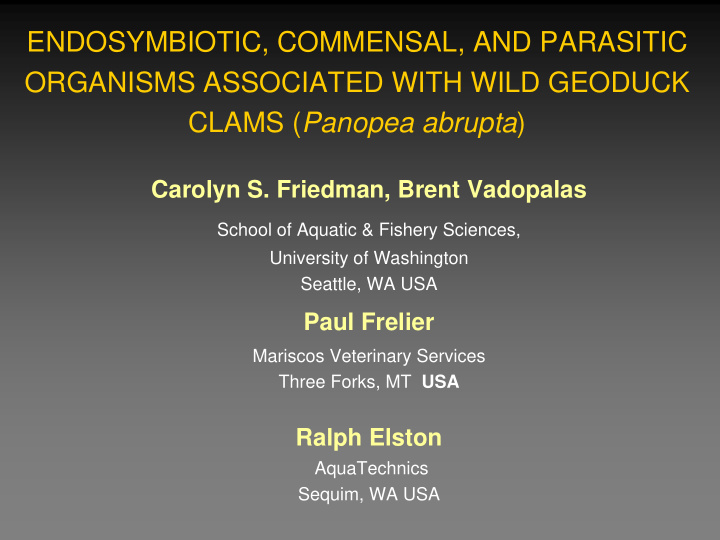



ENDOSYMBIOTIC, COMMENSAL, AND PARASITIC ORGANISMS ASSOCIATED WITH WILD GEODUCK CLAMS ( Panopea abrupta ) Carolyn S. Friedman, Brent Vadopalas School of Aquatic & Fishery Sciences, University of Washington Seattle, WA USA Paul Frelier Mariscos Veterinary Services Three Forks, MT USA Ralph Elston AquaTechnics Sequim, WA USA
Introduction � Farmed marine invertebrates are often non-native species � Criticism often focuses on the impacts of non-native and potentially invasive species on local species/ecosystems • Target and non-target species – Including pathogens � Farming of native species may reduce potential concerns related to exotic species � However, culturing native species within their natural range ensures that farmed and wild organisms can � Interbreed � Compete for the same resources � Share parasites and diseases
Introduction 2 � Cultured and wild animals may have disease impacts on one another � Parasites or disease agents are naturally present in wild populations � Prevalence and intensity varies with species, locale, density, environmental conditions….. � Disease organisms can achieve epidemic status in dense populations � High density plantings may facilitate disease transmission both within cultured and between wild and cultured populations � Successful management or control of a disease agent is facilitated by an understanding of the presence and prevalence of potential pathogens in a population
We need to collect baseline data on the presence, identity and impact of parasites and diseases commonly encountered in the environment/species in question
Geoducks
Methods � Collected wild geoduck clams from three sites in the greater Puget Sound two times during two years � May and late September-early October 2007 � August 2008 and January 2009 � Freshwater Bay, Thorndyke Bay and Totten Inlet in Washington state soundwaves.usgs.gov/2005/02/research.html
Processing samples: Geoduck Anatomy www.jamestowntribe.org/ geoduck/anatomy.gif
Summary of Geoduck Health from Totten Inlet � Sexes: 58% Male, 40% female, 2% unknown � Parasites: � Microsporidia-like • Siphon: 7.5% • Steinhausia -like in ova 9.8% • Intestinal submucosa parasites 30% � Gill RLO 6.8% � Fungi 1.5% � Diseases: � Siphon hyperkeratosis 17.3% � Digestive tubule inflammation 5.3% � Clogged gill water tubules 2.2% � Occasional warts � Siphon discoloration
Normal Intestinal Submucosa Submucosal Intestinal Parasites
Normal Siphon Siphon with multifocal Normal Siphon aggregations of hemocytes and microsporidia-like parasites
Non-Acid Fast H&E PAS + Parasite in siphon: possible microsporidian but non-acid fast so identity based on morphology alone is unclear
http://www.dpd.cdc.gov/DPDx/images/ParasiteImages/M-R/Microsporidiosis
Parasites within GI submucosa and siphon musculature. A. Plasmodia? B. Spores? A Fig 3. Garcia, LS. 2002. J Clin Microbiol. 40(6): 1892–1901 B 400x
Gill RLOs
Steinhausia -like egg parasite
Steinhausia mytilovum Bower, S. 2009. Image provided by J. B. Jones, Department of Fisheries, Government of Western Australia, bjones@agirc.wa.gov.au
Steinhausia -like parasite � Of slides examined to date: � 30% Only seen in geoducks from Totten Inlet � None from Thorndyke Bay � None from Freshwater Bay � Low intensity infections (scale = 1) � Lacked a host response
Mantle Abnormalities � Hyperkeratosis and epithelial discoloration � Warts on siphon epithelium seen periodically http://www-sci.pac.dfo-mpo.gc.ca/geoduck/images/wart1_e.htm
Conclusions � Baseline data is important to assess the health of our native and farmed populations � We have detected 5 parasites in Puget Sound geoduck populations � We need to develop tools to further our understanding of the host-parasite relationships of these parasites
Acknowledgements � WDFW – Bob Sizemore and Shellfish Dive Team � WDNR – Celia Barton and DNR Divers � Jamestown S’Klallam Tribe – Kelly Toy and colleagues � Joth Davis – Taylor and Baywater Inc � Adriana Santa Cruz -UW � Frank Morado – NOAA
Acknowledgements � National Sea Grant – National marine aquaculture initiative � Washington Sea Grant – Washington state geoduck program � School of Aquatic and Fishery Sciences, University of Washington
Recommend
More recommend